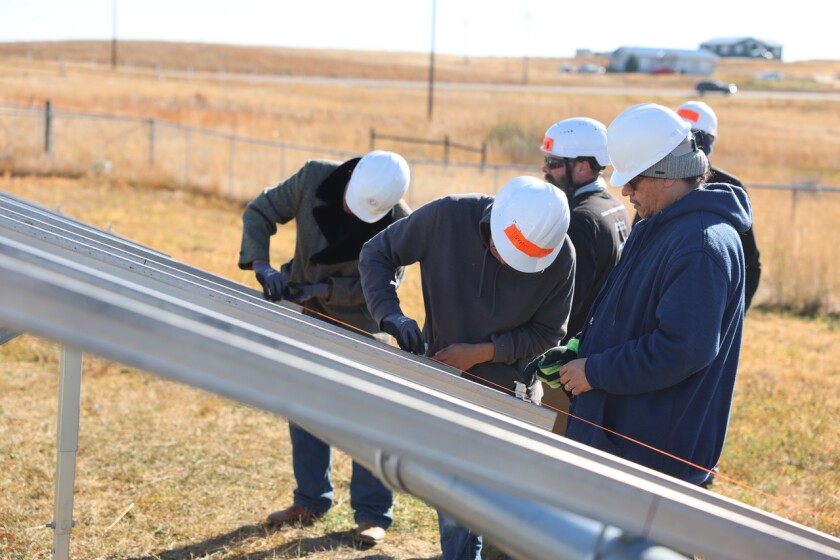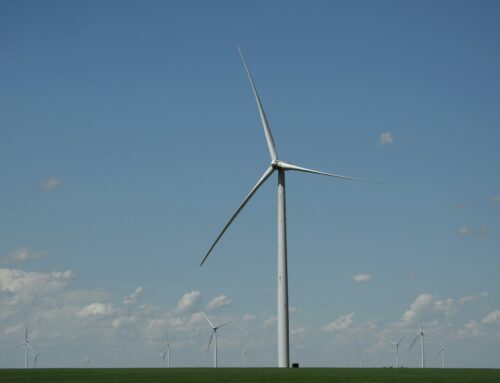Policy reversals stall North Dakota’s clean energy momentum
October 28, 2025
BISMARCK — When federal solar funding was withdrawn earlier this year, Cody Two Bears had to inform dozens of tribal members that their jobs were no longer available.
“At full capacity, we were going to hire up to 60 people within our organization alone to disperse this project within five years,” said Two Bears, founder of Indigenized Energy on the Standing Rock Sioux Reservation. “I was up to about 30 employees. So, I was about halfway there within the first year of launching this program.”
Two Bears’ nonprofit had been preparing to manage a $135.6 million share of the now-canceled Solar For All program, which would have brought rooftop solar to thousands of low-income tribal homes across a five-state region.
When the program was scrapped, so were dozens of potential good-paying clean energy jobs.
“The part that really is frustrating is that we had a lot of hope, and we had a lot of opportunity,” Two Bears said. “That just kind of took the spirit out of our people. When you create a lot of opportunity and just take it away from people that need it the most, that’s really catastrophic.”
The loss of Solar For All has forced organizations like Indigenized Energy to scale back and pivot.
“There’s opportunity out there, but not as much anymore,” Two Bears said. “So, people are just pivoting and shifting and looking for alternatives, either alternative job placements for now, some are finding jobs within renewable energy or elsewhere that are more sustainable, just until we get through this storm, and understanding where this federal government’s going to head.”
Two Bears said the funding would have helped with long-term energy sovereignty for tribal nations participating in the program, and his nonprofit was going to be in it for the long haul, not only installing and training people to use the systems but also providing maintenance and upkeep so the systems would last.
A revolving fund from any profits off the systems as well as insurance policies would have been used to keep them intact going forward, he said.
The MHA Nation had estimated the program could have added around 8,500 rooftop solar installations to homes in its territory alone.
Indigenized Energy completed two ground-mounted residential solar projects with Solar For All funding before the program was cut, one on Oglala Sioux tribal land in South Dakota and a similar system on Chippewa Cree tribal land in Montana.
Dozens of members of both tribes were trained during those installation projects, with several later hired by the nonprofit or other contractors. Those projects presented an estimated savings of at or just above $1,000 annually per household connected to the system, according to the nonprofit.
Another nonprofit group, Coalition for Green Capital, was awarded $125 million through the Solar For All program to install rooftop solar projects in rural and tribal areas in both North and South Dakota. That award would have also targeted lower-income families.
Slower clean energy job growth
Jobs in fields related to wind, solar, battery storage, energy efficiency and other clean energy sectors grew at their slowest pace since 2020 in North Dakota last year, according to data from a nonpartisan business group.
Still, by adding 300 jobs in 2024, those sectors continued to outpace job creation in other traditional energy sectors, which lost 685 jobs in the same time, the data from E2 and Evergreen Climate Innovations shows.
North Dakota currently has 9,513 jobs in the clean energy sector, compared to around 30,000 directly employed in North Dakota’s oil and gas industry.
“Just compared to the overall workforce, we do see that clean energy economy jobs are growing faster, and that’s certainly true for North Dakota, where you have clean energy jobs growing three and a half times faster than the overall economy,” Micaela Preskill, E2’s Director of State Advocacy, said of the 2024 data.
However, policy changes from the One Big Beautiful Bill repealing or phasing out certain Inflation Reduction Act clean energy tax credits and cuts to grants and federal programs related to the clean energy sector are expected to slow clean energy employment growth in the state.
Besides the impacts on Indigenized Energy, backtracking on infrastructure investments has also reduced hiring plans for other companies in the region.
Ryan Warner, co-owner of Lightspring Solar in Bismarck, said the company recently hired new staff to increase its numbers by around 30 to 40%.
If the recent federal cuts and tax changes hadn’t occurred, the company would have likely increased staff by 100 to 200% he said.
“We were expecting a lot more hiring with those grant dollars that got suspended or taken back,” Warner said. “We’re continuing to grow, but not at the same rate we would have otherwise, had those things gone forward.”
The growth of the sector remains to be seen and is dependent on the impact of the federal policy changes and cuts.
“It’s a really significant part of the overall workforce and economy,” E2’s Preskill said. “We’ve got to keep that trajectory going and find opportunities to make sure that these federal headwinds don’t impact this trajectory in a way that would be bad for North Dakota.”
Cass County had the most clean energy-related jobs with 2,629, followed by Burleigh County with 1,304, Grand Forks County with 844, Williams County with 820 and Ward County with 798.
Increased energy demand, prices
The federal energy policy changes and funding repeals come at a time when energy demand is increasing, driven by the development of data centers, residential growth and other industrial developments.
The need for energy from a variety of sources — whether from renewables or traditional sources — continues to grow.
The changes also come as electricity costs in North Dakota rose at an estimated 5.5% over the past year, largely driven by increased use by data centers as well as grid strain and transmission congestion fees.
In September, Basin Electric Power Cooperative authorized a rate increase of $6 per megawatt-hour for its customers, an increase of around 10%, starting on Jan. 1. A 19% rate hike for customers of Xcel Energy in the eastern part of the state is also proposed, potentially raising costs on average by around $270 annually if approved.
A report released by Grid Strategies LLC at the end of 2024 predicts energy demand will grow nationally by 16% over the next five years, necessitating the addition of around 128 gigawatts of new electricity capacity by 2029.
“Obviously, the energy industry is very important to North Dakota, and one macro trend that we see is that power is in demand,” said Ian Adams, managing director at Evergreen Climate Innovations.
Adams said while overall load growth had long been flat, demand is now increasing significantly.
“So, the ability to deliver new sources of power is important,” Adams said. “In a world where we are short of power, and in an environment where we need significantly more power, where we’re not replacing, we’re adding, there’s a lot of opportunity, I think, for the energy space in North Dakota.”
E2 and Evergreen Climate Innovations have already tracked $22 billion in canceled clean energy funding and related private investments stemming from federal policy changes, reducing the ability to add new power sources fast enough.
More cuts coming?
Other potential funding cuts include major projects like Project Tundra, a carbon-sequestration project tied to the Milton R. Young Station coal-fired power plant, and the Heartland Hydrogen Hub.
The cuts were flagged by reporting in early October by Politico’s E&E News regarding a U.S. Department of Energy list that has recently been circulating on Capitol Hill.

Contributed photo
A Minnkota Power Cooperative spokesperson, the power company backing Project Tundra, said the company was aware of the reports but hadn’t received any communication or notice regarding changes in the project’s status from the DOE.
The Politico report indicated that North Dakota Republican Sen. Kevin Cramer had confirmed the authenticity of the list.
Cramer told NDNC on Oct. 23 that he did authenticate the list and that it had cast a “very broad net” and that it prompted pushback from his office and the rest of the North Dakota congressional delegation to the DOE.
Cramer said neither Project Tundra nor the Heartland Hydrogen hub developers received official notice of any changes to funding. He did say that if they were to receive such notification, they should prepare to appeal.
“My advice to people at these projects is at least start the research piece and prepare carefully and prepare to appeal if you get it,” Cramer said.
As far as impacts to other programs like Solar For All, Cramer said that because it originated in the Inflation Reduction Act, targeting it was “significant to the current administration.”
Another program in uncertainty is LIHEAP, or the Low Income Home Energy Assistance Program, a federal program helping lower-income people cover energy costs.
Funding for 2025 has already been distributed to states, and North Dakota’s Department of Health and Human Services said it is still operating normally for the nearly 38,000 individuals who access those funds in the state.
Changes to the application process for LIHEAP were made in the OBBB this summer, and there are open questions about how it will be funded for 2026 due to the current debate over the federal budget package.
“One thing we need to do is get the government open so that money can flow,” Cramer said, adding that more needs to be done to get energy prices down — particularly heating fuels and natural gas — which would also help reduce costs to residents.
“LIHEAP remains a lifeline for people in our part of the country,” Cramer said.
The North Dakota News Cooperative is a non-profit news organization providing reliable and independent reporting on issues and events that impact the lives of North Dakotans. The organization increases the public’s access to quality journalism and advances news literacy across the state. For more information about NDNC or to make a charitable contribution, please visit newscoopnd.org.
More North Dakota Stories
This story was originally published on NewsCoopND.org.
____________________________________
This story was written by one of our partner news agencies. Forum Communications Company uses content from agencies such as Reuters, Kaiser Health News, Tribune News Service and others to provide a wider range of news to our readers. Learn more about the news services FCC uses here.
Search
RECENT PRESS RELEASES
Related Post



